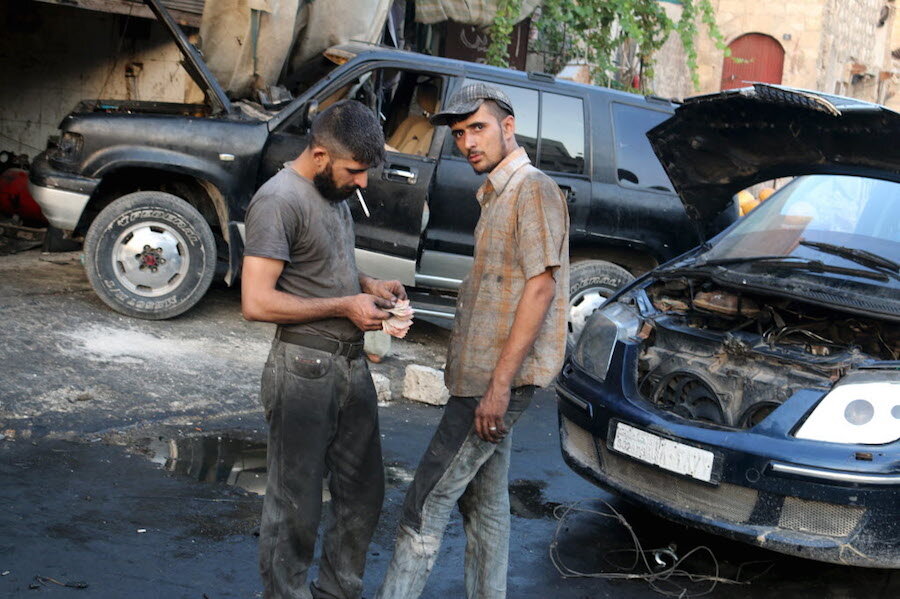Syrian war: As neighbors seek border enclaves, a de facto partition?
Loading...
| BEIRUT, Lebanon and AMMAN, Jordan
The agreement between the United States and Turkey to establish some form of protected zone in northern Syria that is free of the extremist Islamic State heralds a potentially significant shift in Syria’s grueling civil war.
While the details of how the countries will enforce the zone remain unclear, its implementation coincides with Syria’s acknowledgement that a long-heralded contraction of territory under its control is necessary.
One country closely watching developments in northern Syria is Jordan, which, like Turkey, has taken in large numbers of Syrian refugees and watched with concern as extremist factions have rolled back Syrian army control of the country. For months Jordan has been mulling the establishment of its own buffer zone in southern Syria, according to Jordanian officials, regional analysts, and foreign diplomats.
Last week, Syrian President Bashar al-Assad admitted that his weakened army will have to abandon some areas of the country, signaling the anticipated pullback to more defendable regime lines between Damascus and the Mediterranean coast.
Such a move could allow greater space for Turkey and Jordan to expand their influence into Syria, which would harden the partition of the country for years to come, analysts say. Already, the Turkish lira is being used by traders in northern Syria, and there has been some discussion, according to Arab diplomats, of making the Jordanian dinar legal currency in southern Syria should Amman establish its own buffer zone.
“I think we are going to see Syria hemorrhaging and the neighbors becoming more involved,” says Andrew Tabler, a Syria expert with the Washington Institute for Near East Policy.
Tougher stance on Islamic State
Turkey has long been a determined champion of the Syrian rebel forces hoping to end the Assad family’s 45-year rule. It even turned a blind eye to the presence of Islamic State (IS) militants who used Turkey as a gateway to reach Syria.
However, Turkey’s stance on IS hardened following a July 20 deadly suicide bombing in Turkey and a clash between IS militants and Turkish soldiers that left an army officer dead. Ankara has granted the US permission to use Incirlik Air Base in southern Turkey for its anti-IS operations and has carried out its own airstrikes against IS in Syria.
What impact these buffer zones have on Syria depends on what form of zone the US and Turkey envisage – and whether they can agree on a shared goal. The initial plan appears to be to create an IS-free zone stretching between Azaz in the west to Jarablus in the east, a distance of 55 miles. Reports suggest it could reach as deep as Al Bab, 20 miles south of the Turkish border.
Washington remains wary of being dragged into an escalating military commitment in Syria. Turkey, however, has multiple interests, including diminishing the IS threat, limiting the power of the Kurds, who already control a swath of northern Syria, and bolstering anti-Assad rebel forces.
“There’s an agreement on keeping ISIS out of that area and sealing the border, but there isn’t an agreement on making a ‘safe area’ that you can defend and for the Syrian opposition to be based out of. That’s an aspirational thing,” says Mr. Tabler.
Ground forces required
But for Turkey, the jihadists are not the only target. Ankara has watched with unease the progress made by the Syrian Kurdish YPG militia, which, backed by US air power, has seized territory from IS and begun to carve out an autonomous Kurdish enclave.
It’s unclear who would lead the fight against IS in the new zone. Turkey backs rebel groups in northern Syria with proven military track records against IS and the Syrian army, but they include groups such as Jabhat al-Nusra, Al Qaeda’s Syrian affiliate, which the US regards as a terrorist organization.
US officials have said the designated enclave isn’t a “no-fly zone.” Still, the Syrian Air Force appears to be changing its tactics in anticipation of such an operation. The independent Syrian Human Rights Committee reported Thursday that since the Turkish air operations against ISIS in Syria began on July 24 there have been no helicopter-borne barrel bomb attacks on the northern city of Aleppo.
“I think the US is calling it one thing – this ISIS-free zone – and the Turks are interpreting it their own way,” says Tabler. “I think that is probably the way it will continue and we will see what the Turks do with it.... We just don’t know at the moment.”
A southern zone?
Jordan also has been considering the benefits and costs of establishing a similar zone in southern Syria. But Jordan, which still has diplomatic ties with Syria, is adopting a more cautious approach. Jordanian officials say the motivation for creating a buffer would be to confront a proximate threat, such as the deployment of IS along the border.
Under plans drawn up some months ago, the proposed zone would extend some 20 miles into Syria. It would be policed by moderate rebels and militias formed of the minority Druze sect, with the Jordanian army providing artillery and air support.
“We believe we have partners on the ground who know the terrain and will be better equipped to enforce the zone,” says a Jordanian military official with knowledge of the plans.
In theory, a buffer zone could would allow for the return of 65 percent of the 1.4 million Syrian refugees living in Jordan who come from the city of Deraa and surrounding villages.
However, unlike Turkey, which opposes the Assad regime, Jordanian officials say their forces would not attack Syrian regime forces or strongholds and that they would not contemplate a buffer zone until Assad’s forces have departed the south.
“Jordan will only act if the chaos in Syria threatens to spill over – then a buffer zone will be critical,” the military official says.







